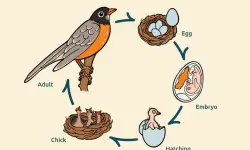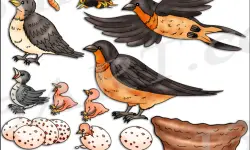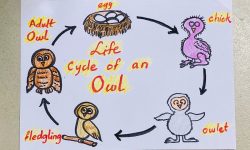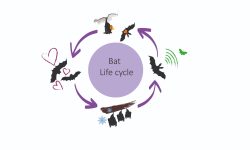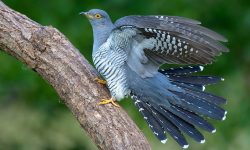Among the whispering grasses and open skies of southern Australia, a bold black silhouette surveys the land with sharp eyes and an unmistakable voice. This is the Australian Raven (Corvus coronoides), one of the continent’s most intelligent and adaptable birds. Often misunderstood as a mere scavenger or mistaken for its crow cousins, the Australian Raven is far more complex—an ecological participant, a vocal performer, and a survivor of both wilderness and urban landscapes.
As the largest native corvid in Australia, the Australian Raven plays a crucial role in grassland ecosystems, acting as both predator and cleaner. Its distinctive appearance and behavior make it not only a key part of the outback’s soundscape but also a silent guardian of open country.
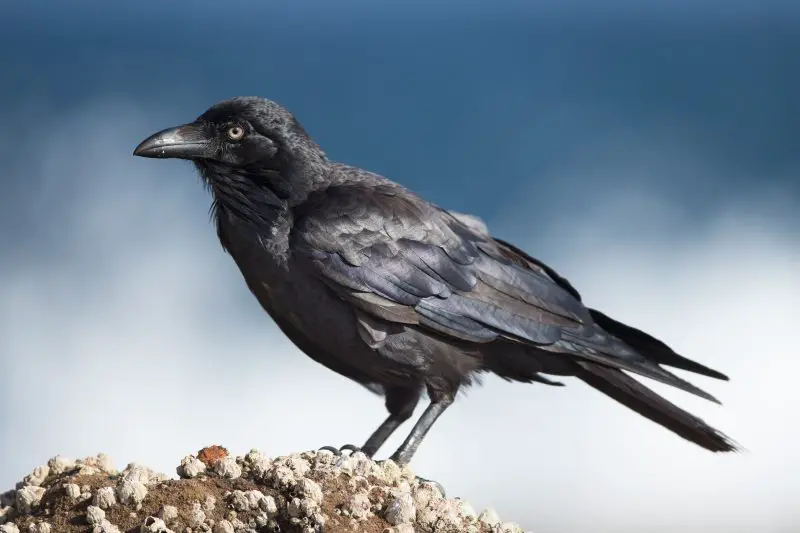
Identification and Appearance
A Striking Figure in Black
With its commanding presence and rich black plumage, the Australian Raven (Corvus coronoides) is one of the most unmistakable birds in the southern skies. Measuring 50 to 55 centimeters (20 to 22 inches) in length, it cuts a bold silhouette whether striding through an open paddock or perched on a windswept gum tree. In the right light, its feathers shimmer with subtle hues of blue and purple, giving the bird an almost metallic sheen—like polished obsidian set against the bright Australian sky.
One of its most distinctive features is the long, shaggy hackles—specialized throat feathers that dangle like a dark ruff beneath its beak. These feathers are often flared when the raven calls, confronts a rival, or performs territorial displays, lending it a somewhat regal, even dramatic air.
Its eyes are piercing white, standing out vividly against the surrounding darkness of the face. In adult birds, this pale iris is sharp and intense, almost ghostly in contrast. Juvenile ravens begin life with blue-grey eyes, which gradually lighten with age, marking the bird’s passage from youth to maturity.
The beak is heavy and powerful, slightly curved at the tip and entirely black. It’s built for versatility—capable of tearing meat, cracking open tough insects, and probing soil for hidden morsels. Together with the bird’s keen eyesight and intelligence, this robust beak makes the raven a master forager in both natural and urban landscapes.
Distinguishing the Raven from Its Crow Cousins
Australia is home to several species of black corvids, and even experienced birders can sometimes find it challenging to tell them apart. The Little Raven, Forest Raven, and Torresian Crow all share a similar size and color palette. But the Australian Raven stands apart in several subtle but telling ways.
First and foremost is its long, shaggy throat hackles, more prominent than those of any other Australian corvid. These feathers are not only distinctive but also expressive, often puffed out dramatically during calls and displays. Then there’s the voice—a slow, mournful wail that seems to stretch across the landscape: “aaah… aaaah… aaaaahhh.” Unlike the sharper, briefer calls of other crows and ravens, this vocalization is haunting and deeply resonant, often echoing through paddocks and woodlands like a distant lament.
In terms of posture, the Australian Raven tends to stand taller and appear more upright, giving it a statelier demeanor. It is also generally larger than the Little Raven and carries itself with a more deliberate, thoughtful air when foraging or walking.
Habitat provides another important clue. While species like the Torresian Crow prefer tropical regions, and the Forest Raven sticks mostly to Tasmania and highland forests, the Australian Raven dominates the open woodlands, grasslands, and urban edges of southeastern and southwestern Australia. If you hear a long, aching call echoing across a sheep paddock at dawn, chances are, you’re hearing this dark sentinel of the south.
Geographic Range and Habitat
Distribution Across Australia
The Australian Raven (Corvus coronoides) claims its territory across southeastern and southwestern Australia, where its presence is deeply woven into both wild and human-altered landscapes. Strong populations are found throughout New South Wales, Victoria, South Australia, the Australian Capital Territory, and the southern parts of Queensland. In the west, an isolated but stable population resides in the southwestern corner of Western Australia, where the open countryside provides ideal conditions for feeding and breeding.
In contrast, the Australian Raven is notably absent from tropical northern Australia, where the Torresian Crow dominates. Likewise, in the harsh, arid deserts of central Australia, the smaller and more drought-tolerant Little Crow takes its place. This uneven distribution reflects the raven’s preference for moderate climates and open woodlands rather than the extremes of the continent’s central and northern reaches.
Habitat Preferences
Highly adaptable and observant, the Australian Raven thrives in a wide range of habitats, but it clearly favors open country interspersed with scattered trees or structures. It is frequently seen traversing natural grasslands, foraging through dry savannas, or perched silently atop dead branches in wooded pasturelands. These open environments not only offer a clear line of sight for spotting food or threats but also provide a variety of nesting sites and ground-based foraging opportunities.
In agricultural zones, ravens follow tractors across freshly plowed soil, waiting for insects or seeds to be unearthed. Grazing lands attract them with easy pickings, including carrion, food scraps, and animal afterbirths. Yet despite this connection to rural life, Australian Ravens are no strangers to the city. In urban and suburban areas, they roost in tall trees, nest on buildings or light poles, and patrol parks and schoolyards with an uncanny awareness of human behavior. Their presence in such diverse settings speaks to a remarkable ability to read, adapt to, and even anticipate changes in the environment.
Although they are comfortable near humans, Australian Ravens continue to favor spaces that offer open ground for foraging and elevated vantage points for calling and observation. Whether drifting through the open bush or scanning a city street from a rooftop, this raven remains a master of both wild terrain and the modern Australian landscape.
Behavior and Intelligence
Vocalizations and Social Communication
The voice of the Australian Raven is one of its most haunting and unmistakable features. Its call—a slow, drawn-out wail—echoes across fields and suburbs alike, often described as mournful, almost human in its emotional weight. These deep, resonant notes are more than just background noise; they are territorial signals, mating calls, and sometimes warnings to rivals or potential predators. Males often perch high above the landscape, fluffing out their long throat hackles as they call, creating a dramatic visual to accompany the eerie sound.
Far from being limited to a single cry, ravens are capable of a wide range of vocalizations, from soft mutters and clicks to sharp barks and complex mimicry. They use this vocal toolbox to communicate with mates, signal danger, coordinate with their young, or even deceive competitors. In some cases, they’ve been known to imitate sounds from their environment, including human speech, especially in areas where they live in close proximity to people.
Tool Use and Problem Solving
What truly sets the Australian Raven apart is its exceptional intelligence. These birds are not only alert observers of their surroundings but also active problem-solvers, capable of behaviors that rival those of some primates.
Field studies have recorded ravens dropping nuts or shelled prey onto hard surfaces, such as rocks or roads, to break them open—a clear example of tool use. Some have been observed waiting near busy roads, timing their approach after vehicles have passed to safely retrieve cracked food. Others use human routines to their advantage, following garbage trucks or foraging near picnic areas shortly after visitors depart.
This cognitive flexibility allows Australian Ravens to thrive in urban environments, where they must constantly interpret shifting patterns of human behavior, traffic flow, and food availability. They’ve been seen opening unattended lunch bags, flipping over objects to reveal insects underneath, and even working in loose cooperation with other ravens to corner prey or explore new spaces.
Their intelligence has enabled them to survive and adapt in landscapes transformed by agriculture, development, and climate change, where more specialized or timid species have declined. The Australian Raven is a bird that not only watches the world—it learns from it, interacts with it, and shapes its future within it.
Diet and Foraging Habits
Omnivorous and Opportunistic
The Australian Raven is a true generalist, thriving on a wide and flexible diet that shifts with the landscape and the seasons. As an opportunistic omnivore, it feeds on whatever is most accessible, adapting seamlessly to the resources available in each environment. In natural grasslands and open woodland, it hunts insects like beetles, grasshoppers, and caterpillars, picking them from the ground with swift precision. It will also take small reptiles, fledgling birds, and even rodents when the opportunity arises, displaying a surprising capacity for predation.
Beyond live prey, the raven does not shy away from carrion. In fact, it plays a vital role in the ecosystem as a scavenger, cleaning up dead animals and leftover organic material. This function becomes especially important in rural and semi-wild areas, where it helps prevent the buildup of decaying matter and reduces the spread of disease.
Yet the Australian Raven is just as at home foraging in human-altered environments. In agricultural regions, it can often be seen following behind tractors or herds of livestock, snatching up worms, insects, and food scraps unearthed by the machinery or animals. In cities and suburbs, it patrols parks, schoolyards, and bins, deftly exploiting human refuse, discarded food, and urban greenery. It even shows selectivity in its diet, favoring soft fruits, grains, and certain seeds when available.
Role as an Ecological Cleaner
The Australian Raven’s dietary habits go beyond personal survival—they serve a critical ecological function. By consuming carrion and organic waste, the bird helps limit the spread of harmful bacteria and parasites, especially in livestock areas or places where other scavengers are scarce. Its presence contributes to nutrient cycling, breaking down dead matter and returning key elements to the soil through natural processes.
This scavenging behavior places the raven in the same ecological category as vultures and other top-level cleaners. Whether consuming a roadkill carcass or leftover food tossed from a picnic bench, it ensures that nothing organic goes to waste. In doing so, the Australian Raven acts as an unseen custodian of the land, supporting both natural systems and human-dominated landscapes through quiet, tireless labor.
Breeding and Reproductive Cycle
Mating Behavior
The breeding season for the Australian Raven begins in late winter or early spring, when the days grow longer and the land begins to stir with new life. During this time, long-term monogamous pairs reaffirm their bonds through a series of elaborate vocal and visual displays. These rituals include synchronized calling, wing-flicking, and strutting displays, especially near potential nest sites. The male often perches prominently, puffing out his shaggy throat feathers and letting loose his deep, mournful calls, announcing both his territory and devotion to his mate.
Once paired, the female selects the nest site—typically high in a tall eucalyptus tree, though she may also choose utility poles, windmills, or other elevated man-made structures, especially in urban areas. Height offers safety from predators and a wide view of the surrounding territory. Ravens tend to return to the same general nesting areas year after year, maintaining a strong familiarity with their breeding grounds.
Nesting and Chick Development
The nest itself is a large, untidy bowl of sticks, constructed with surprising architectural strength. Inside, the female lines it with softer materials such as fur, sheep’s wool, strips of bark, or grasses to cushion and insulate the eggs. A typical clutch contains three to six pale blue-green eggs, speckled with brown blotches that blend naturally with the nest lining and surrounding branches.
The female handles incubation, a process that lasts about 20 days, while the male often remains nearby to guard the nest and provide food. Once the chicks hatch, both parents become attentive caregivers, taking turns feeding the young with a rich diet of insects, small animals, and regurgitated food. The nestlings grow rapidly, fueled by their high-protein meals, and are soon covered in thick black down.
Even after fledging, young ravens remain with their parents for several weeks, learning essential survival skills such as foraging, social communication, and territorial awareness. Family groups often stay loosely connected for some time, with juveniles occasionally seen accompanying their parents well into early adulthood. Eventually, they disperse to establish their own territories, carrying forward the deep intelligence and adaptability that defines their species.
Conservation and Human Impact
Status and Protection
The Australian Raven is currently listed as a species of Least Concern, a designation that reflects its broad geographic range and remarkable adaptability. Unlike many native birds that have suffered from urbanization and agricultural expansion, the Australian Raven has found ways to persist—and even thrive—alongside human activity. Its intelligence, varied diet, and flexible nesting habits allow it to navigate both wild and developed landscapes with ease.
However, this very adaptability has led to conflict in certain rural regions, particularly where agriculture dominates the economy. Some sheep farmers accuse ravens of killing newborn lambs, citing peck marks or missing eyes as evidence. Scientific investigations, however, suggest that such incidents are rarely acts of active predation. In most cases, ravens are scavenging lambs that have already died from exposure, birth complications, or predation by other animals. Still, the perception of the raven as a livestock threat has prompted localized culling and population control efforts, especially in southern sheep-grazing regions.
This tension highlights the challenges of conserving a species that is both ecologically beneficial and occasionally seen as a pest.
Living Alongside Humans
In more urbanized areas, the Australian Raven has proven to be a master of adaptation. It nests in tall buildings, power poles, and roadside trees, and is a common sight in parks, playgrounds, and suburban streets, where it forages confidently for scraps and insects. Its bold behavior and curious intelligence make it hard to ignore—and not always welcome.
Some city dwellers regard ravens as noisy nuisances, especially during breeding season when their wailing calls become more frequent and intense. Others view their scavenging habits as unsightly or disruptive. Yet these birds provide valuable ecological services: they help control insect and rodent populations, remove carrion, and clean up organic waste, often playing the same ecological role in cities that vultures or foxes do in more remote environments.
The Australian Raven’s ability to bridge the wild and the human-altered is a testament to its resilience. But it also serves as a reminder: our perceptions of wildlife often shape conservation outcomes more than the facts themselves. Recognizing the raven not as a threat, but as a clever and essential part of Australia’s ecosystems, opens the door to coexistence rooted in respect and ecological understanding.
Cultural Significance
In Indigenous Australian cultures, ravens often appear in mythology and oral tradition as clever tricksters, messengers, or even protectors of the land. Their eerie calls, mysterious behavior, and enduring presence in the landscape have made them a subject of both reverence and caution.
For modern Australians, the raven’s voice is part of the country’s natural soundscape—echoing through quiet mornings, roadside trees, and empty fields, reminding us of the wild intelligence that still inhabits the spaces between the city and the bush.
Conclusion
The Australian Raven (Corvus coronoides) is more than just a black bird calling from a rooftop or roadside—it is a guardian of grasslands, a scavenger with purpose, and a survivor of shifting landscapes. Its presence in Australia’s open country is a sign of resilience, ecological function, and adaptability.
Whether cleaning up carrion, hunting grassland insects, or raising its young in tall city trees, the Australian Raven continues to play a crucial role in balancing nature’s systems. Far from being a mere shadow in the sky, this intelligent bird is a vital, vocal, and enduring part of Australia’s wild heritage.

